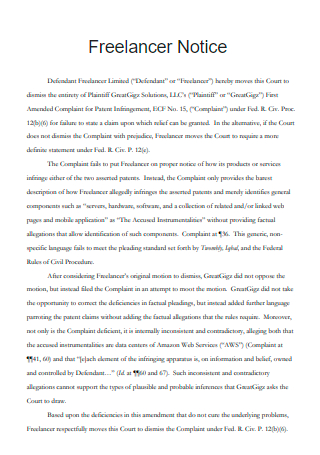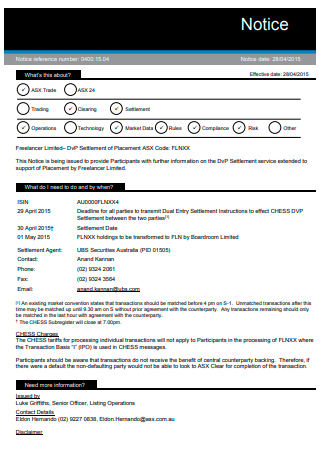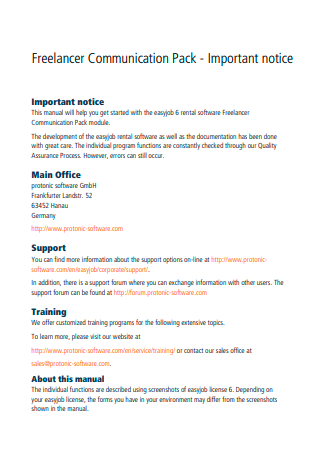3+ SAMPLE Freelancer Notice
FREE Freelancer Notice s to Download
3+ SAMPLE Freelancer Notice
What Is a Freelancer Notice?
Things Every Potential Freelancer Should Know
Tips for Telling Clients You Are Leaving
How to Write a Freelance Notice
FAQs
What are my rights as a freelancer?
How much do freelancers charge?
Why is it vital to notify clients that you are leaving?
What Is a Freelancer Notice?
A freelancer notice is a formal, written, or printed statement to a customer. It is written in a very exact language, with no unnecessary information. A Freelance notice period is essentially a technique for conveying information about any issue or concern. If it is not exact, the readers may not dedicate as much time to reading it. Make sure you don’t add any unnecessary information that might lead to a misinterpretation of the true message. You can view the available freelance notice template. This will give you a decent concept of how to write a concise freelance notice letter.
Things Every Potential Freelancer Should Know
According to Statista, in the United States in 2020, there will be 59 million persons undertaking freelance employment. This is a rise from 2014 when there were around 53 million freelancers. This indicates a high demand for freelancers in a variety of specializations and industries, as well as a gradual drop in typical 9-to-5 day jobs. Being a self-employed freelancer, on the other hand, entails running your own business. Whether you are ready or not, you must be your boss. The list is curated to inform you of things all future and present freelancers should consider regarding the industry so you can better grasp the nature of freelance employment.
Tips for Telling Clients You Are Leaving
As mentioned, you may encounter difficult clients who will be draining to work with in the long run. As long as you are not bound by a contract, you can terminate the working relationship of your choice. But to do so in a professional manner, then you can make use of the tips laid out for you in the curated list.
How to Write a Freelance Notice
This part of the article will serve as a guide or basis for you to write the document. Use this freelance notice format to ensure you don’t forget anything of importance especially if the client is expecting the working relationship to end and may have concerns. As a freelance writer, you need to aim to explain thoroughly why you are leaving.
1. Introductory Details
To begin, you must identify the freelancing notice with the title for which it is intended. The date you are writing it on is followed by your established business name and present address. If this is not relevant, your complete name or the name you use to engage with your customer will suffice. Following that, provide the entire name of the person or client to whom it is written, as well as the date of your final day of employment, as determined by your employment contract and notice period agreement.
2. Clearly Explain That You are Moving On
Breaking up is difficult, which can result in a lot of sugar coating and wishy-washy rhetoric. You may believe you are sparing your client’s ego, but this might complicate your message. You must state unequivocally that you will no longer be working on their initiatives. You may take a while to compose this part as you must word it in a way that will not be misinterpreted by any means unnecessary. Focus on stating it positively and objectively than have it be a personal reason.
3. Give a Brief Reason
You don’t have to offer the client a long-winded explanation for why you are leaving for brighter pastures, but they do need some form of the reason so they don’t wonder where they went wrong. This may be kept brief. If you believe they are underpaying you, clarify that the rates are no longer comparable with what you can make elsewhere. If you are just tired of their duties, explain that you need that time to work on other Projects. Again, you don’t need to get into the nitty-gritty; just one phrase explaining why you are leaving is enough to bring some much-needed closure.
4. Express Gratitude and Offer Referral
Even if things went sour and you can’t wait to be done with the job, the client still gave you a chance, and that deserves some sincere thanks. Make it a point to express how much you loved the job and the opportunity to work with them. Infusing a little positivism might go a long way toward ensuring that you leave on good terms. If you are worried about leaving your customer hanging, recommend another freelancer who you believe could take over the reins and do excellent work for them.
5. Provide an End Date
It’s also a good idea to include an expected completion date, especially if one isn’t specified in your contract. This ensures that you and your customer are on the same page regarding the Time Track and may collaborate to complete any outstanding tasks before moving on. Don’t forget to include wrapping up the document with a signature to mark that you are conscious and have full awareness of the contents of the document.
FAQs
What are my rights as a freelancer?
As a freelancer, you have complete control over your workflow. It is your legal right to choose how, when, and where you accomplish your work. You may also establish your remuneration with each customer and even subcontract out sections of your work. Unless you have signed a contract specifying that you are transferring ownership to the customer, as a freelancer, you hold the copyright to the majority of your work. You are the default copyright owner of any work you create.
How much do freelancers charge?
According to the Payoneer survey, which included 150 nations and over 7,000 freelancers worldwide, freelancers earn an average of $21/hour. Freelancers around the world charge the following hourly rates starting around $5 and up to 16%. As a freelancer, you must balance the best use of your time. Understanding the amount of billable time for a project will allow you to determine whether it makes sense in comparison to the number of non-billable hours necessary to complete that project. You may also charge more for smaller jobs and provide a discount for larger or longer-term contracts.
Why is it vital to notify clients that you are leaving?
When you plan to retire, you must notify your clients in advance. Many people consider it common protocol and proper manners, particularly when ending long-term customer ties. Allowing for a transition phase also allows you to supply your clients with your personal contact information to stay in touch, end your professional connection on a positive note, or link them with a new point of contact within the firm. Furthermore, if you are looking for a new career in the same field, your previous clients may be interested in working with you at another firm, giving you a position, or referring you to new clients.
As a freelance developer, you will encounter clients of varying personalities, tasks of varying degrees of difficulty, and comments or feedback that may or may not be as pleasing to the ears. At the end of the day, completed projects will be seen as a success and non-completed ones will save you from the stress of having to see the end of the process.




